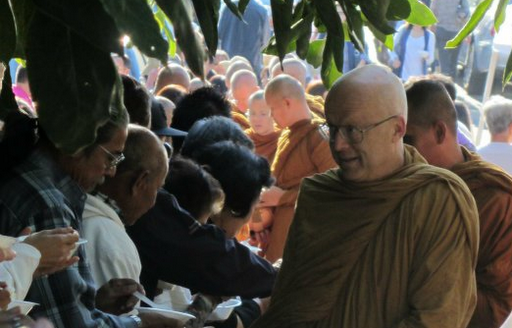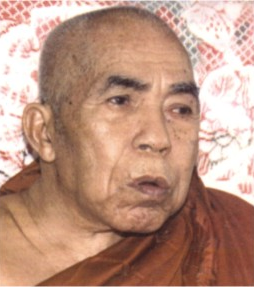Ajahn Brahmali provides another response to Thanissaro Bhikkhu’s letter. Several of these points are also elaborated upon at more length in Sudhamma bhikkhuni’s response.
Reposting all these letters from Facebook is exhausting, so I must continually thank Sobhana Bhikkhuni for the time set aside to share these.
A Response to Ajahn Thanissaro’s Letter on the Simultaneaous Ordination of 2 or 3 Bhikkhunis
In his recent letter to Ajahn Nyanadhammo (posted on the dhammalight website) Ajahn Thanissaro makes the case that ordaining 2 or 3 bhikkhunis simultaneous is invalid, and consequently so is the recent ordination in Perth. I am not persuaded by Ajahn Thanissaro’s argument, and the rest of this letter is an attempt to substantiate why.
First of all, I agree with Ajahn Thanissaro (see part 12 of his letter) that sanghakamma should be done without defects and that it is not satisfactory to deviate from the Vinaya on grounds of compassion. One can perhaps interpret the Vinaya in a compassionate way, but not altogether ignore its statutes. It follows that if the ordination performed in Perth can be shown to be invalid, I would certainly accept that. (Ajahn Brahm has specifically told me that this is his position too.) From the point of view of the newly ordained bhikkhunis, they would clearly be in an untenable position if they had serious doubts about the validity of their ordination. Further, since it seems that a large number, perhaps most, existing Theravada bhikkhunis have been ordained by the same procedure as the one used in Perth, the issues brought up by Ajahn Thanissaro are clearly of great importance.
Given the above, I have read through Ajahn Thanissaro’s argument carefully. My conclusion is that, as his argument stands, he has not shown that a bhikkhuni ordination in which 2 or 3 candidates are ordained simultaneously is invalid. I will now examine Ajahn Thanissaro’s argument, starting with his point 11 where he argues directly from the Canonical Vinaya.
In subpoint 11b Ajahn Thanissaro states that “There are no examples of transaction statements authorized in the Canon where the sheer form of the statement would intrinsically entail breaking a rule”. Actually, on careful consideration, there are several such examples. According to Mv I 70.1-3 a bhikkhu incurs a dukkata for ordaining someone without a bowl and/or robes. The ordination itself, however, seems to be valid, since this section (i.e. Mv I 70) stands in direct contrast to the immediately preceding one (Mv I 69.4) where the ordination is not valid. The commentary supports this interpretation by stating outright that the ordination is valid. Now, regardless of whether the ordinand has a complete set of bowl and/or robes, the sanghakamma statement of the ordination always states that he/she does (Mv I 76.10). In the case where the candidate does not have a complete set, everyone who partakes in the ordination would know that this was the case (in an earlier part of the ordination procedure (Mv I 76.3) the bowl and robes are pointed out to the candidate) and thus the ordination statement would amount to a conscious lie. Thus, although it is clear that this ordination is valid, the sanghakamma statement involves a deliberate lie, which of course is a pacittiya offense under pacittiya 1. And, contrary to Ajahn Thanissaro, in the case where it is known that a candidate for ordination does not have a bowl and/or robes, “the sheer form of the statement would intrinsically entail the breaking of a rule” and it would still be valid. It follows that, because Mv I 70 implicitly allows the ordination of someone without a bowl and/or robes, it also establishes a situation where the procedure intrinsically entails the breaking of a rule.
And this is not the only case. The same passage at Mv I 70 also states that the bhikkhus involved in ordaining someone without a bowl and/or robes incur a dukkata offense. The monks involved would be performing a sanghakamma that intrinsically entails breaking a rule but which nevertheless would be valid. Another example is the declaration in the ordination statement, whether this in fact is true or not, that the candidate is “free from obstructing things”. Again, the ordination is valid in most instances even when the candidate is not free from these obstructions.
Ajahn Thanissaro then states, in point 11c, that “Thus the allowance at Mv I 74.3 – allowing a single proclamation to mention two or three candidates for bhikkhu ordination – cannot be extended to bhikkhunis, for such a statement would intrinsically be ‘apart from the Vinaya … apart from the Teacher’s instruction’.” But since I have just shown that it is possible to perform a valid ordination and at the same time incur a pacittiya or dukkata offense, this part no longer holds. It is clearly undesirable to perform an ordination while committing an offense, and one should obviously avoid this if at all possible, but it does not void the procedure. As a consequence of this, the rest of Ajahn Thanissaro’s argument, 11c-11f, also fails.
There is another reason why Ajahn Thanissaro’s argument does not hold. The Vinaya is quite clear about the grounds on which any sanghakamma is invalid, and these do not include the situation where the “form of the statement would intrinsically entail the breaking of as rule”. The sort of factors that are required to make an ordination valid include the following:
- The candidate to be ordained is present;
- The candidate is 20 years old or more;
- The candidate is not one of several types of ‘unqualified’ persons, or an animal;
- The quorum for performing the ordination is complete;
- The Sangha is united (vagga); that is, all the monks within the sima are present at the ordination, or they have given their consent;
- The ordination statement contains exactly one motion (ñatti) and three announcements (kammavaca), in that order;
- Nobody present speaks out against the ordination;
- The procedure performed is an ordination, not some other sanghakamma.
It is only if such requirements – that is, requirements that are specifically mentioned in the Vinaya – are not met that the ordination fails, and only in these cases is the ordination considered “apart from the Vinaya … apart from the Teacher’s instruction” and “not a transaction and should not be carried out”. Any supposed grounds for failure that fall outside of what is specified in the Vinaya are a matter of personal opinion only, and cannot be a universally accepted standard. Since, in my view, Ajahn Thanissaro’s argument is a matter of personal opinion, it cannot be accepted as universally valid.
In general, according to the Vinaya the following circumstances need to be satisfied for any sanghakamma to be valid:
“And how, monks, is a (sangha-)kamma united and in accordance with the Dhamma? … If, monks, concerning a (sangha-)kamma with one motion and three announcements, the motion is established first (and) then the (sangha-)kamma is performed with three announcements; the bhikkhus who should be present are present; consent has been received from those who should give consent; those who are present do not speak against the act – then the (sangha-)kamma is united and in accordance with the Dhamma.” (Mv IX 3.9)
Again, there is nothing here about the validity of sanghakamma depending on its being performed without breaking other Vinaya rules, or indeed that it depends on “the sheer form of the statement” not intrinsically entailing the breaking of a rule (see Ajahn Thanissaro’s point 11b).
At this point I would like to return to Ajahn Thanissaro’s point 5 where he declares that “This sort of transaction statement, because it intrinsically entails the breaking of a rule, would thus be totally unauthorized.” The words “totally unauthorized” are unclear and emotionally loaded. It is certainly true that nowhere in the Canonical Vinaya is such an ordination statement explicitly “authorized”, and if this is what Ajahn Thanissaro means by “totally unauthorized” then I have no problem with it. But when he goes on to state that this means that the ordination is “apart from the Vinaya … apart from the Teacher’s instruction” and “not a transaction and should not be carried out” he goes too far. As I have already shown, it is quite possible to break a pacittiya rule while performing an ordination and for the ordination still to be fully valid.
I have already responded to Ajahn Thanissaro’s point 6 (in my response to his point 11) but to recapitulate: in Mv I 70 there are good reasons to believe that the ordination is valid even though the ordinand does not possess a bowl and/or robes. The ordination ceremony in this case entails an intrinsic breaking of a rule, that is, pacittiya 1. If this argument and the ones above are accepted, then Ajahn Thanissaro’s further discussion in points 7-10 becomes irrelevant since it hinges on what had been established in his points 5 and 6. In particular, it may well be true that not mentioning the upajjhaya in the ordination procedure makes the ordination invalid, but this is beside the point. The lack of an upajjhaya can arguably be considered a breach of the conditions given in the Parivara, but no such breach exists in the case of ordaining 2 or 3 bhikkhunis at the same time. In contrast to the case where there is no upajjhaya, for which Ajahn Thanissaro’s argument may be valid, an ordination of 2 or 3 bhikkhunis at the same time does not breach any of the stipulations made in the Canonical Vinaya for a valid sanghakamma. His points 8-10, then, do not add anything to what he has already stated in points 5 and 6, which I have already discussed.
A final and important point is that bhikkhu pacittiya 65, which concerns the invalid ordination of someone less than 20 years old, specifically states in the rule itself that the ordination is invalid. No such statement is found in bhikkhuni pacittiyas 82 or 83, and thus it is reasonable to assume that the breaching of these rules cannot in itself invalidate the ordination. Even the commentary (Sp IV 945,4-10) does not say anything about the ordination having failed.
In conclusion, I cannot see that Ajahn Thanissaro has established what he claims to have established, that is, that “a bhikkhuni ordination in which the transaction statements mentioned more than one candidate per statement would not be considered valid, and the candidate would not count as accepted” (Ajahn Thanissaro’s point 10).





